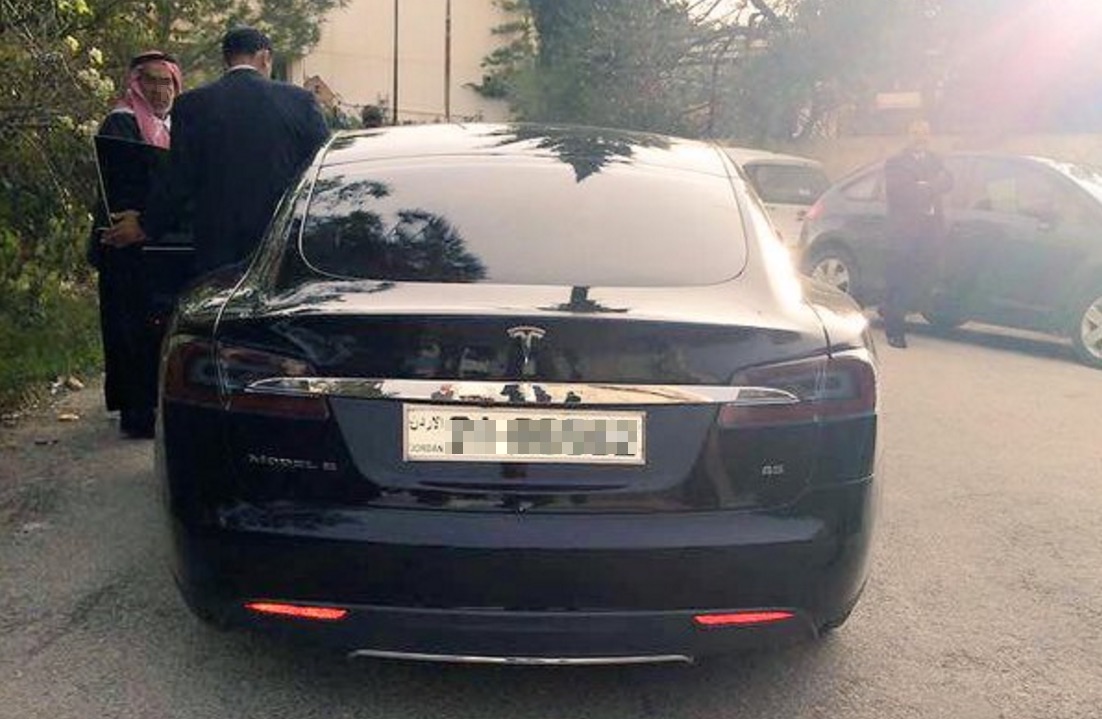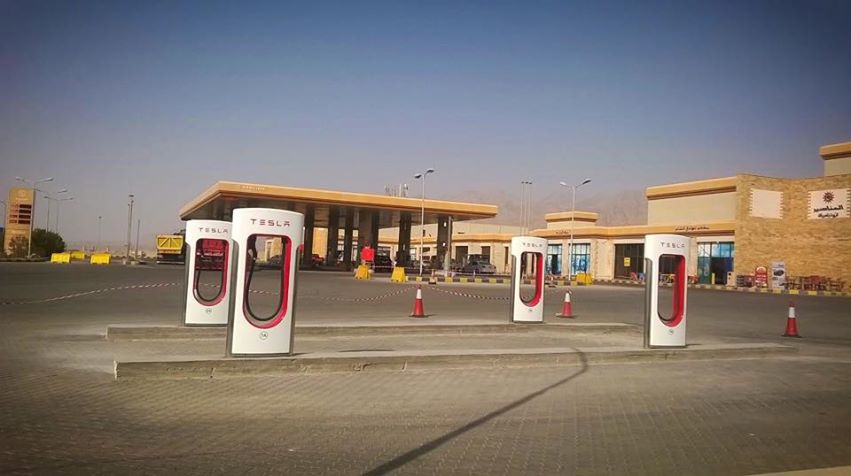News
When is Tesla coming to Dubai and the United Arab Emirates?

If you think people living in one of the world’s most oil rich nations would not be interested in sustainable energy and driving electric automobiles, think again. Citizens of the United Arab Emirates are deeply involved in sustainability due to the harsh climates they live in. They’re also deeply interested in experiencing cutting edge technology and no better way to do that than to drive a Tesla, the most technologically advanced car in the world.
The UAE is comprised of 7 emirates located along the shores of the Persian Gulf on the eastern side of the Arabian peninsular. At the present time, the closest Tesla Superchargers are located hundreds of miles to the west in Jordan.

Tesla Supercharger location in Jordan via Facebook, September, 2015
Back in 2015, Elon Musk tweeted that other nations in the area would soon be included in the Tesla community, but external factors like war and political insecurity have kept Tesla from developing more of a presence in the Middle East. At the present time, no new Superchargers in the area are planned, according to Tesla’s Supercharger map.
None of that has kept buyers in the UAE from bombarding Tesla with requests for information about purchasing a Tesla. In fact, some of the strongest interest the company has received in its upcoming Model 3 comes from that area.
@sAlmaneei already in Jordan. Rest of states in region next year.
— Elon Musk (@elonmusk) October 21, 2015
Last April, Ryan Kennedy, a sales manager at Tesla in the United States, told UAE news source 7days that the Middle East is now one of Tesla’s biggest markets even though charging infrastructure is almost nonexistent in the area. “Out of all our international requests, we get the most calls from the Middle East region… almost every day.”
Kennedy said that buyers are “eager to know how can they get Tesla cars over there,” then added, “We have a lot of buyers in that particular market and with Tesla Motors looking to expand locations across the globe by mid-2017, Dubai could be an important candidate.”
This week has been Sustainability Week in Abu Dhabi, an annual event sponsored by Masdar Corporation, a $15 billion dollar multinational business that promotes cleantech research and investments. Its CEO, Dr Ahmad Belhoul, has been involved in sustainability initiatives since 2006 — long before the world agreed to wide ranging climate protocols in Paris in December, 2015.
The buzz among the attendees at this year’s event is that Tesla is very close to opening a showroom in either Abu Dhabi or Dubai — or possibly both. It’s not official yet. A Tesla spokesperson would say only, “We don’t have anything to share yet but will certainly keep you posted on any news relating to the UAE.” according to a report from CleanTechnica.
If the rumors are correct, Tesla would be joining BMW in the Middle East market. The German company already sells its i3 electric sedan and i8 hybrid electric sports car there. The Emirates are also home to dealerships for McLaren, Ferrari, and other ultra luxury performance cars. Since the new Tesla Model S P100D is faster to 60 mph than any of those other cars, it could prove to be a very popular choice for wealthy residents of the Emirates.
The United Arab Emirates has become a premium global brand thanks to the reputation for excellent service earned by Emirates airline. Adding Tesla’s own prestigious brand to the UAE international profile would make perfect sense. We will keep you informed of any official word from Tesla about expanding operations to include showrooms and Supercharger facilities in the UAE.

Elon Musk
Elon Musk and Tesla AI Director share insights after empty driver seat Robotaxi rides
The executives’ unoccupied tests hint at the rapid progress of Tesla’s unsupervised Robotaxi efforts.

Tesla CEO Elon Musk and AI Director Ashok Elluswamy celebrated Christmas Eve by sharing personal experiences with Robotaxi vehicles that had no safety monitor or occupant in the driver’s seat. Musk described the system’s “perfect driving” around Austin, while Elluswamy posted video from the back seat, calling it “an amazing experience.”
The executives’ unoccupied tests hint at the rapid progress of Tesla’s unsupervised Robotaxi efforts.
Elon and Ashok’s firsthand Robotaxi insights
Prior to Musk and the Tesla AI Director’s posts, sightings of unmanned Teslas navigating public roads were widely shared on social media. One such vehicle was spotted in Austin, Texas, which Elon Musk acknowleged by stating that “Testing is underway with no occupants in the car.”
Based on his Christmas Eve post, Musk seemed to have tested an unmanned Tesla himself. “A Tesla with no safety monitor in the car and me sitting in the passenger seat took me all around Austin on Sunday with perfect driving,” Musk wrote in his post.
Elluswamy responded with a 2-minute video showing himself in the rear of an unmanned Tesla. The video featured the vehicle’s empty front seats, as well as its smooth handling through real-world traffic. He captioned his video with the words, “It’s an amazing experience!”
Towards Unsupervised operations
During an xAI Hackathon earlier this month, Elon Musk mentioned that Tesla owed be removing Safety Monitors from its Robotaxis in Austin in just three weeks. “Unsupervised is pretty much solved at this point. So there will be Tesla Robotaxis operating in Austin with no one in them. Not even anyone in the passenger seat in about three weeks,” he said. Musk echoed similar estimates at the 2025 Annual Shareholder Meeting and the Q3 2025 earnings call.
Considering the insights that were posted Musk and Elluswamy, it does appear that Tesla is working hard towards operating its Robotaxis with no safety monitors. This is quite impressive considering that the service was launched just earlier this year.
Elon Musk
Starlink passes 9 million active customers just weeks after hitting 8 million
The milestone highlights the accelerating growth of Starlink, which has now been adding over 20,000 new users per day.

SpaceX’s Starlink satellite internet service has continued its rapid global expansion, surpassing 9 million active customers just weeks after crossing the 8 million mark.
The milestone highlights the accelerating growth of Starlink, which has now been adding over 20,000 new users per day.
9 million customers
In a post on X, SpaceX stated that Starlink now serves over 9 million active users across 155 countries, territories, and markets. The company reached 8 million customers in early November, meaning it added roughly 1 million subscribers in under seven weeks, or about 21,275 new users on average per day.
“Starlink is connecting more than 9M active customers with high-speed internet across 155 countries, territories, and many other markets,” Starlink wrote in a post on its official X account. SpaceX President Gwynne Shotwell also celebrated the milestone on X. “A huge thank you to all of our customers and congrats to the Starlink team for such an incredible product,” she wrote.
That growth rate reflects both rising demand for broadband in underserved regions and Starlink’s expanding satellite constellation, which now includes more than 9,000 low-Earth-orbit satellites designed to deliver high-speed, low-latency internet worldwide.
Starlink’s momentum
Starlink’s momentum has been building up. SpaceX reported 4.6 million Starlink customers in December 2024, followed by 7 million by August 2025, and 8 million customers in November. Independent data also suggests Starlink usage is rising sharply, with Cloudflare reporting that global web traffic from Starlink users more than doubled in 2025, as noted in an Insider report.
Starlink’s momentum is increasingly tied to SpaceX’s broader financial outlook. Elon Musk has said the satellite network is “by far” the company’s largest revenue driver, and reports suggest SpaceX may be positioning itself for an initial public offering as soon as next year, with valuations estimated as high as $1.5 trillion. Musk has also suggested in the past that Starlink could have its own IPO in the future.
News
NVIDIA Director of Robotics: Tesla FSD v14 is the first AI to pass the “Physical Turing Test”
After testing FSD v14, Fan stated that his experience with FSD felt magical at first, but it soon started to feel like a routine.

NVIDIA Director of Robotics Jim Fan has praised Tesla’s Full Self-Driving (Supervised) v14 as the first AI to pass what he described as a “Physical Turing Test.”
After testing FSD v14, Fan stated that his experience with FSD felt magical at first, but it soon started to feel like a routine. And just like smartphones today, removing it now would “actively hurt.”
Jim Fan’s hands-on FSD v14 impressions
Fan, a leading researcher in embodied AI who is currently solving Physical AI at NVIDIA and spearheading the company’s Project GR00T initiative, noted that he actually was late to the Tesla game. He was, however, one of the first to try out FSD v14.
“I was very late to own a Tesla but among the earliest to try out FSD v14. It’s perhaps the first time I experience an AI that passes the Physical Turing Test: after a long day at work, you press a button, lay back, and couldn’t tell if a neural net or a human drove you home,” Fan wrote in a post on X.
Fan added: “Despite knowing exactly how robot learning works, I still find it magical watching the steering wheel turn by itself. First it feels surreal, next it becomes routine. Then, like the smartphone, taking it away actively hurts. This is how humanity gets rewired and glued to god-like technologies.”
The Physical Turing Test
The original Turing Test was conceived by Alan Turing in 1950, and it was aimed at determining if a machine could exhibit behavior that is equivalent to or indistinguishable from a human. By focusing on text-based conversations, the original Turing Test set a high bar for natural language processing and machine learning.
This test has been passed by today’s large language models. However, the capability to converse in a humanlike manner is a completely different challenge from performing real-world problem-solving or physical interactions. Thus, Fan introduced the Physical Turing Test, which challenges AI systems to demonstrate intelligence through physical actions.
Based on Fan’s comments, Tesla has demonstrated these intelligent physical actions with FSD v14. Elon Musk agreed with the NVIDIA executive, stating in a post on X that with FSD v14, “you can sense the sentience maturing.” Musk also praised Tesla AI, calling it the best “real-world AI” today.








